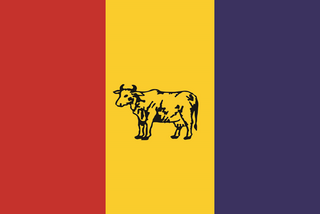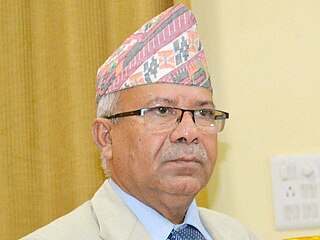
The Nepali Congress is a social democratic political party in Nepal and the largest party in the country. The party has 870,106 members as of the party's 14th general convention in December 2021, making it the largest party by membership in Nepal. In June 2023, the party started online membership since the emergence of youth leaders in vital posts to attract youths to the party. The party is led by former prime minister, Sher Bahadur Deuba since the party's thirteenth general convention in 2016. The party won 89 seats in the 2022 general election and is currently the largest parliamentary group in the House of Representatives.

The Communist Party of Nepal (Unified Marxist–Leninist) (Nepali: नेपाल कम्युनिष्ट पार्टी (एकीकृत मार्क्सवादी-लेनिनवादी), romanized: nēpāl kamyuniṣṭ pārṭī (ēkīkṛt mārksavādī-lēninavādī); abbr. CPN (UML)) is a communist political party in Nepal. The party emerged as one of the major parties in Nepal after the end of the Panchayat era.

Sher Bahadur Deuba is a Nepali politician and former prime minister of Nepal. He has also been serving as the president of the Nepali Congress since 2016. Deuba has served five terms as prime minister and is the Member of Parliament for the parliamentary constituency of Dadeldhura 1.

Nepal Ratna Girija Prasad Koirala, affectionately known as Girija Babu, was a Nepalese politician. He headed the Nepali Congress and served as the Prime Minister of Nepal on four occasions: from 1991 to 1994, 1998 to 1999, 2000 to 2001, and 2006 to 2008. He was the Acting Head of State of Nepal between January 2007 and July 2008 as the country transitioned from a monarchy to a republic.

The Rastriya Prajatantra Party is a constitutional monarchist and Hindu nationalist political party in Nepal.

Man Mohan Adhikari (Magi) (Nepali: मन मोहन अधिकारी; 9 June 1920 – 26 April 1999) was the 31st Prime Minister of Nepal from 1994 to 1995, representing the Communist Party of Nepal (Unified Marxist-Leninist). He was the first communist Prime Minister in Nepal and one of the first communist politician in the world to be democratically elected as a head of government.

Bishweshwar Prasad Koirala, better known as B. P. Koirala, was a Nepali revolutionary, political leader, and writer. He was the Prime Minister of Nepal from 1959 to 1960. He led the Nepali Congress, a social democratic political party. He was the grandfather of Bollywood actors Manisha Koirala and Siddharth Koirala, the elder brother of former prime minister Girija Prasad Koirala and the younger brother of former prime minister Matrika Prasad Koirala.

Krishna Prasad Bhattarai also known as Kishunji was a Nepalese political leader. He was one of the main leaders involved in transitioning Nepal from an absolute monarchy to a democratic multi-party system.

Madhav Kumar Nepal, is a Nepalese politician and former Prime Minister of Nepal. He served as prime minister from 32 May 2009 to 6 February 2011.

The House of Representatives, commonly known as Pratinidhi Sabha, is one of the houses of the Federal Parliament of Nepal, with the other house being the National Assembly. Members of the House of Representatives are elected through a parallel voting system. They hold their seats for five years or until the body is dissolved by the President on the advice of the council of ministers. The house meets at the International Convention Centre in Kathmandu.
General elections were held in Nepal on 15 November 1994 to elect the House of Representatives. The election took place after the Nepali Congress government collapsed and King Birenda called new elections. The results showed that the Communist Party of Nepal won the most seats in the House of Representatives and Man Mohan Adhikari became Prime Minister at the head of a minority government.

Sushil Prasad Koirala was a Nepalese politician and the Prime Minister of Nepal from 11 February 2014 to 10 October 2015. He was also President of the Nepali Congress from 2010 to 2016, having earlier served in various capacities in the party.

Dhyan Govinda Ranjit a.k.a. Dhyan Govinda Ranjitkar is a Nepalese politician and a leader of Nepali Congress. He is a member of Nepalese constituent assembly/Nepalese Parliament. Ranjit has twice been elected to the Nepalese Constituent Assembly from Kathmandu constituency on two consecutive elections. He is an elected member of Nepali Congress parliamentary party working committee representing Province-3. He was a representative of Nepali Congress in work editing committee. He is the Past President of Kathmandu District Committee of Nepali Congress.

General elections were held in Nepal on 9 May 1981 to elect members of the Rastriya Panchayat. 80% of the seats were elected through adult universal suffrage; this was the first election through universal suffrage held in Nepal in 22 years. However, political parties were banned at the time, and the main underground opposition forces called for a boycott of the election.
Bhadrakali Mishra was a Nepali politician. In a political career lasting more than 50 years, several of which he spent in exile, he held numerous ministerial portfolios and was also the Chairman of King Birendra's Raj Parishad Standing Committee after the establishment of multi-party democracy in 1990.

Ganesh Prasad Rijal was a Nepali politician. He took part in the 1951 democratic revolution of Nepal and later in 1959, elected as a member of parliament from Ilam district. On 15 December 1960, King Mahendra suspended the constitution, dissolved the elected parliament, dismissed the cabinet, imposed direct rule and imprisoned the then prime minister Bishweshwar Prasad Koirala and his closest government colleagues. After King Mahendra's coup, Rijal was exiled to India along with other leaders and workers of Nepali Congress party. During his exile, he resided in Kalimpong and Naxalbari in Indian state of West Bengal. He returned homeland in 1975 following government granting amnesty, and continued his political career, residing in Damak and Kathmandu simultaneously.

Nepali National Congress was a political party in Nepal that was founded in 1947. The party was founded to protest the Rana rule in Nepal. Dilli Raman Regmi, B. P. Koirala, Matrika Prasad Koirala, Ganesh Man Singh, Krishna Prasad Bhattarai, Mahendra Narayan Nidhi were founding members of the party.
The second Girija Prasad Koirala cabinet was formed on 15 April 1998 after the appointment of Nepali Congress leader Girija Prasad Koirala as prime minister by King Birendra. Girja was supported by CPN (Marxist–Leninist). The cabinet was expanded on 21 April 1998. On 26 August 1998, the cabinet was reshuffled and ministers from CPN (Marxist–Leninist) where included. After CPN (Marxist–Leninist) withdrew their support for the government on 11 December 1998, Girija resigned as prime minister ten days later.

















